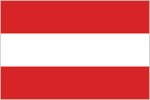Compare
Saint Helena, Ascension, and Tristan da Cunha
to
Austriato
AustriaThe GDP per capita in Austria is $42,600 while in Saint Helena, Ascension, and Tristan da Cunha it is $7,800
This entry shows GDP on a purchasing power parity basis divided by population as of 1 July for the same year. A nation's GDP at purchasing power parity (PPP) exchange rates is the sum value of all goods and services produced in the country valued at prices prevailing in the United States. This is the measure most economists prefer when looking at per-capita welfare and when comparing living conditions or use of resources across countries. The measure is difficult to compute, as a US dollar value has to be assigned to all goods and services in the country regardless of whether these goods and services have a direct equivalent in the United States (for example, the value of an ox-cart or non-US military equipment); as a result, PPP estimates for some countries are based on a small and sometimes different set of goods and services. In addition, many countries do not formally participate in the World Bank's PPP project that calculates these measures, so the resulting GDP estimates for these countries may lack precision. For many developing countries, PPP-based GDP measures are multiples of the official exchange rate (OER) measure. The differences between the OER- and PPP-denominated GDP values for most of the wealthy industrialized countries are generally much smaller.
Source:
CIA World Factbook
The per capita consumption of electricity in Saint Helena, Ascension, and Tristan da Cunha is 956kWh while in Austria it is 7,758kWh
This entry consists of total electricity generated annually plus imports and minus exports, expressed in kilowatt-hours. The discrepancy between the amount of electricity generated and/or imported and the amount consumed and/or exported is accounted for as loss in transmission and distribution.
Source:
CIA World Factbook
Austria has an unemployment rate of 5.60% while Saint Helena, Ascension, and Tristan da Cunha has 14.00%
This entry contains the percent of the labor force that is without jobs.
Source:
CIA World Factbook
The number of deaths of infants under one year old in a given year per 1,000 live births in Austria is 4.16 while in Saint Helena, Ascension, and Tristan da Cunha it is 14.71.
This entry gives the number of deaths of infants under one year old in a given year per 1,000 live births in the same year; included is the total death rate, and deaths by sex, male and female. This rate is often used as an indicator of the level of health in a country.
Source:
CIA World Factbook
Saint Helena, Ascension, and Tristan da Cunha consumes 0.5418 gallons of oil per day per capita while Austria consumes 1.0752
This entry is the total oil consumed in gallons per day (gal/day) divided by the population. The discrepancy between the amount of oil produced and/or imported and the amount consumed and/or exported is due to the omission of stock changes, refinery gains, and other complicating factors.
Source:
CIA World Factbook
The life expectancy at birth in Austria is 80.17 while in Saint Helena, Ascension, and Tristan da Cunha it is 79.21.
This entry contains the average number of years to be lived by a group of people born in the same year, if mortality at each age remains constant in the future. The entry includes total population as well as the male and female components. Life expectancy at birth is also a measure of overall quality of life in a country and summarizes the mortality at all ages. It can also be thought of as indicating the potential return on investment in human capital and is necessary for the calculation of various actuarial measures.
Source:
CIA World Factbook
The annual number of births per 1,000 people in Austria is 8.76 while in Saint Helena, Ascension, and Tristan da Cunha it is 10.03.
This entry gives the average annual number of births during a year per 1,000 persons in the population at midyear; also known as crude birth rate. The birth rate is usually the dominant factor in determining the rate of population growth. It depends on both the level of fertility and the age structure of the population.
Source:
CIA World Factbook
 With its 8,223,062 people, Austria is the
94th largest country in the world by
population. It is the 114th largest country in the
world by area with 83,871 square kilometers.
With its 8,223,062 people, Austria is the
94th largest country in the world by
population. It is the 114th largest country in the
world by area with 83,871 square kilometers.
Once the center of power for the large Austro-Hungarian Empire, Austria was reduced to a small republic after its defeat in World War I. Following annexation by Nazi Germany in 1938 and subsequent occupation by the victorious Allies in 1945, Austria's status remained unclear for a decade. A State Treaty signed in 1955 ended the occupation, recognized Austria's independence, and forbade unification with Germany. A constitutional law that same year declared the country's "perpetual neutrality" as a condition for Soviet military withdrawal. The Soviet Union's collapse in 1991 and Austria's entry into the European Union in 1995 have altered the meaning of this neutrality. A prosperous, democratic country, Austria entered the EU Economic and Monetary Union in 1999.
Check out the recommended reading list below for great sources of information on Austria